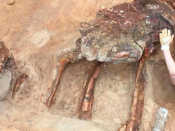Por André Henriques (cE3c - Computational Biology and Population Genomics).
Pollinators, such as wild bees, provide important ecosystem services and are crucial for the maintenance of most agricultural crops. However, the agricultural expansion is considered a major cause of global biodiversity decline and it is unclear how the agricultural landscapes threaten the genetic structure, genetic diversity, and adaptive potential of wild bee communities.
To unravel these elements a population genomic approach was used on seven widespread wild bees species across the Iberian Peninsula. Additionally, we used a contrast sampling design (small-scale farming landscapes vs. natural landscapes) to explore how three of those seven wild bee species responded to the selective pressures imposed by their local environments. Our results showed that genetic lineages from the Ebro River valley, the Pyrenees Mountain or the Baetic mountains seem different form the rest of Iberia, supporting the “refugia within refugia” hypothesis and role of the Iberia as the cradle of biodiversity. Moreover, we also found a weak effect of the two contrasting landscapes on gene flow and we did not find any reduction in neutral genetic variability when the two environments were compared. However, we identified several loci under selection suggesting that this type of landscape can promote an evolutionary response on these vital insect pollinators, with some loci associated with bioclimatic and land use variables that characterize those landscapes.
Understanding these patterns and processes that generated and maintained wild bees genetic diversity is essential for constructing a knowledge-based conservation strategy for populations inhabiting these unstable habitats.
Transmissão via Zoom (pw: 449696).






















